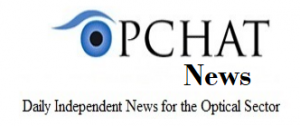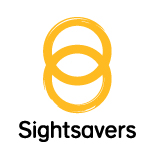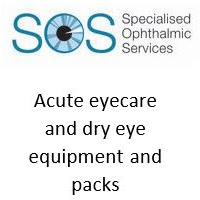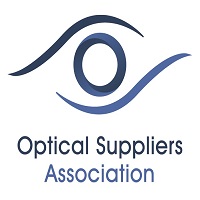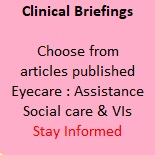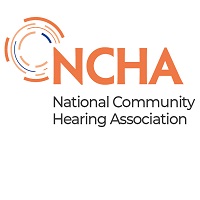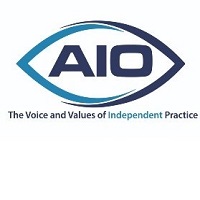New products and Services
Heidelberg Engineering Launch SPECTRALIS SHIFT Technology
Heidelberg Engineering Launch SPECTRALIS SHIFT Technology
Heidelberg Engineering have announced new software and hardware upgrades that will deliver powerful enhancements to the image quality and workflow of the SPECTRALIS imaging platform. Most significantly, software version 7.0 makes it possible to introduce SHIFT technology.
SHIFT enables clinicians to switch between OCT scan speeds (A-scan rates) to achieve improved outcomes in terms of speed, image quality, sharpness, and detail in different applications. It is now possible to speed up to 125 kHz, which accelerates image acquisition speed by 30%, or slow down to 20 kHz for high sensitivity when imaging traditionally challenging eyes, such as those with significant media opacities.
Other enhancements include the Enhanced Vitreous Imaging (EVI) Mode, which optimises visualisation of details in the vitreous, and a new widefield reflectance filter, which improves usability and increases image quality for MultiColor and IR images captured with the widefield lens.
SPECTRALIS SHIFT
With the introduction of an innovative new technology, SPECTRALIS users will be able to choose the most suitable OCT scan speed for each individual patient. Standard presets ensure an efficient workflow, while practitioners are flexible to modify the OCT acquisition speed to strike the ideal balance between speed and image quality.
The combination of new components within the next generation SPECTRALIS platform gives birth to SHIFT technology, creating synergies that significantly increase efficiency in both OCT and OCTA and deliver images with more detail.
SHIFT enables clinicians to switch between OCT scan speeds for an individualized assessment. It delivers improved performance by offering different A-scan rates for different applications to achieve optimal image quality, while also improving clinical workflow. Standard presets – 125 kHz for OCT angiography (OCTA) and 85 kHz for structural OCT – allow eye practitioners to complete their daily routine more efficiently. 85 kHz is the default scan speed for high structural OCT image quality across the posterior segment, 125 kHz is a faster scan speed for improved workflow and high-quality OCTA and 20 kHz is the high-sensitivity
OCT scan speed for challenging cases.
SHIFT is the first new SPECTRALIS technology submitted by Heidelberg Engineering for review by a notified body under the new EU Medical Device Regulation. This milestone facilitates the introduction of SPECTRALIS with SHIFT technology into all CE markets.
“SHIFT technology delivers the scan speeds needed for optimized performance, improved workflow and customized patient care. With full backward compatibility of existing patient data and functionality, SHIFT easily integrates into existing clinical infrastructures, with minimal training. This acceptance is also a significant milestone in our transition from the old Medical Device Directive to the new EU-MDR,” said Krysten Williams, Head of Global Marketing and Education at Heidelberg Engineering.
Variable A-scan rates for customized patient care: 125, 85 and 20 kHz
125 kHz – A fast scan speed for improved workflow and high OCTA image quality.
125 kHz speeds up image acquisition for OCT angiography by up to 30%. Users will experience increased efficiency in daily clinical routine. Offering the ideal speed-quality ratio for OCTA, 125 kHz increases throughput without any clinically relevant loss in image quality in comparison to the current 85 kHz. The fast acquisition of images allows for visualization of flow, even in miniscule vessels, while minimizing artefacts, resulting in sharp and detailed images of the capillary network.
SPECTRALIS with SHIFT technology offers customized diagnostic OCTA imaging to meet the needs of each individual patient. 125 kHz balances speed and quality for most patients and it is possible to adjust to
85 kHz if the patient’s condition requires longer light exposure.
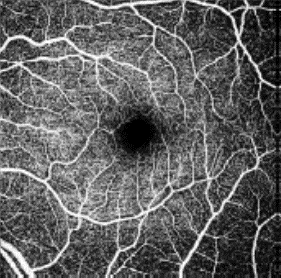
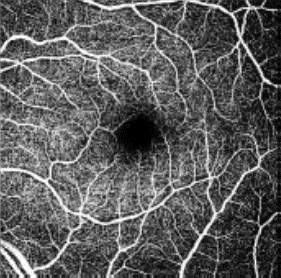
Left: 85 kHz Scan Speed. Right: 125 kHz Scan Speed.
85 kHz – The scan speed for high structural OCT image quality across the posterior segment.
85 kHz has been proven to be the ideal speed-quality ratio for structural OCT imaging, striking the correct balance between efficient workflow and meaningful images to offer confident diagnostics and achieve improved patient outcomes. The default for the Glaucoma Module Premium Edition, 85 kHz provides the image quality required for accurate measurements, while choosing to increase the speed can improve workflow efficiency for a busy glaucoma clinic.
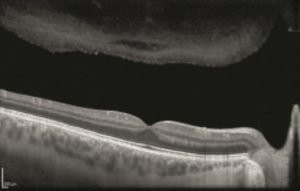
20 kHz – The high-sensitivity OCT scan speed for challenging cases.
20 kHz makes it possible to acquire diagnostic images even in the most challenging cases. It offers improved image quality due to higher sensitivity and better signal-to-noise ratio, resolving details even in eyes with media opacities and small pupils. Users can capture meaningful, high-resolution images when other devices or standard imaging modalities cannot deliver sufficient quality due to cataract, corneal edema or dense floaters.
In challenging cases and in combination with the new Enhanced Vitreous Imaging (EVI) or with Enhanced Depth Imaging (EDI) modes, the 20 kHz scan speed provides you with clinically relevant OCT images of the posterior segment, from vitreous to choroid with better image quality than at higher speeds.
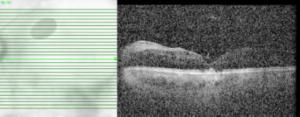
Above: 85 kHz scan speed with ART9 in an eye with corneal edema and retinal vein occlusion.
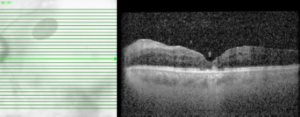
Above: Same eye acquired with 20 kHz scan speed with ART9.

